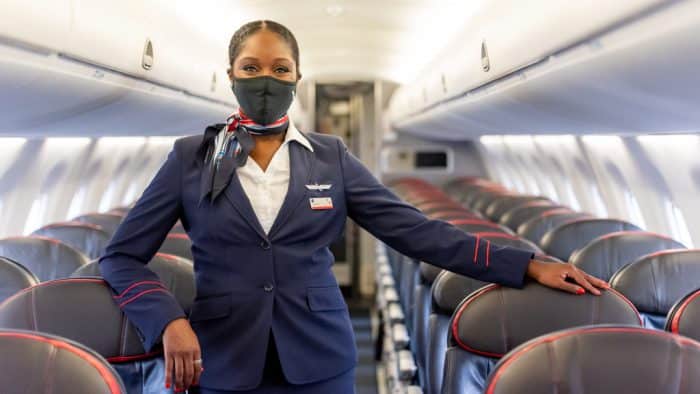Have you considered working as a flight attendant? It’s hard to find fault with a job that provides you with free flights. However, becoming a flight attendant isn’t all sunshine and roses, like vacations to exotic places like Morocco and the Maldives. Training is required, as is working flights that more experienced flight attendants would rather not work. For example, a flight from Atlanta to Tampa at 5 a.m. might be delayed for a long time. However, the flight attendant industry offers opportunities for advancement, workplace friendships, and, perhaps most appealingly, global travel.
You probably have a lot of questions if becoming a flight attendant is something you’re thinking about. Don’t worry; we’ve covered everything you’ll need to get you to the clouds in this article. Just hang on to your device a little longer…
What Should You Do First?
Here’s an interesting fact about working as a flight attendant: After you get the job, you train. It differs from becoming a pilot, where you must obtain a commercial pilot’s license before applying to be an airline pilot. Those who want to become flight attendants must apply to various airlines and be hired. You’ll undergo a three-to-six-week intensive training course if you get the job.
What Is a Flight Attendant?
A flight attendant is someone who assists in ensuring the safety, security, and well-being of the flight crew and passengers. While flight attendants benefit from the opportunity to work in a unique environment, they are frequently subjected to long hours and extended periods away from home.
What Exactly Is the Job of a Flight Attendant?
Flight attendants are in charge of ensuring the safety and comfort of airline passengers. They can work on both commercial and private aircraft. Before the flight, flight attendants are given information about the weather, travel time, and passengers’ needs. Passengers’ primary point of contact is with these attendants. They will respond to questions, assuage fears, and communicate with the pilot as needed. Other duties of a flight attendant include:
- Aiding passengers in boarding
- Assisting passengers in finding their seats and storing their luggage
- Passengers are being watched for suspicious behavior.
- Helping those with small children or special health needs
- Educating passengers on proper safety precautions
- Getting the cabin ready for takeoff and landing
- Keeping passengers calm in the face of turbulence or delays
- Assisting passengers in emergencies
- Assisting passengers in safely deplaning after landing
Flight Attendant’s Average Salary
Flight attendants earn $16.71 per hour on average. On the other hand, salaries can range between $7.25 and $41.05 per hour. The primary factors determining a flight attendant’s earnings are seniority and experience.
How to Become a Flight Attendant
Finish your education
A high school diploma or GED is required to become a flight attendant. A bachelor’s degree, while not required, can improve your employability. The most relevant are marketing, hospitality, tourism, public relations, and communication degrees.
Acquire relevant work experience
Flight attendant positions are highly sought after, and only the best candidates make it past the initial interview. Relevant work experience will boost your CV. A minimum of two years of experience in hospitality, customer service, or sales is required by many airlines. Airlines look for work experience demonstrating your ability to stand for long periods, work overtime, solve problems, and provide excellent customer service.
Create and submit a resume
Create a strong resume that emphasizes your customer service abilities. Highlight any professional or volunteer experience that has allowed you to hone your ability to work with difficult clients. Highlight positions where you were on your feet for long periods or worked extra hours to show that you’re physically capable of meeting the demands of a flight attendant.
Top airlines may only accept resumes for a few hours. So, prepare your resume so you can act quickly if a job opportunity arises for flight attendants.
Pass your flight attendant interview
Before beginning training, prospective flight attendants must pass their interviews. This includes a drug test and a background investigation. Flight attendants must be of sufficient height and weight to reach overhead bins. Your vision must be correctable to 20/40 or better and be in good physical and mental health.
Many employers screen potential flight attendants using video interviews. These may or may not be operational. Consider your surroundings carefully when conducting a video interview, and make sure the background is neat and quiet. Put the camera at eye level and stable to get a clear, steady shot. Airlines prefer a professional image, so dress conservatively. Most prohibit facial piercings, visible tattoos, and unnaturally colored hair.
Finish the airline’s training program
Airlines provide flight attendants with a three- to six-week training program. Throughout the program, you will typically attend training for eight hours per day. This course will teach you to use airport codes, make public address announcements, perform routine job duties, and handle in-flight emergencies. As part of the program, you will complete four supervised test flights. To become a flight attendant, you must complete your training. The majority of airlines require a minimum grade of 90%.
Obtain your FAA Certificate of Proven Proficiency
Once you’ve completed your training, your employer will apply to the Federal Aviation Administration for your Certificate of Demonstrated Proficiency. You must obtain a separate certificate for each aircraft type with which you are certified. Annual training is required to keep your certification current.
Is a College Degree Required?
No, not technically. Most airlines only require applicants to have a high school diploma or GED. On the other hand, an associate’s or bachelor’s degree will only smoothen your chances of getting a job with a major airline. Even better, a degree in marketing, hospitality, communication, or tourism will be a big plus for the airline.
Furthermore, if you have related skills, even if they weren’t acquired through a college education, such as waiting tables, working in a hotel, or hosting at a beachside bar and grill, that could also help you get hired.
Remember that while a college degree is not required, you must be at least 18 years old to apply for a job as a flight attendant.
What Qualities Do Airlines Look For in Applicants?
They expect you to present professionally, preferably with customer service experience, to be personable, and to be able to stand on your feet for extended periods. Does that sound simple? It’s a lot more difficult than you think. Any job in the service industry can be taxing on the body, and being a flight attendant is no exception. On a 19-hour flight from Newark to Singapore, you may be sleep deprived and given few breaks, but you must still be responsible for your cabin. In addition, you must be tall enough to reach the overhead bins and have 20/40 vision. When applying for a position as a flight attendant, you must be able to pass a background check as well as a drug test.
The Training Plan
Once hired by the airline, you will begin your training program. According to the Alaska Airlines website, the training program lasts six weeks and is tuition-free. During training, you will learn how to deal with emergencies such as fires, manage evacuations, use oxygen masks and life vests, and operate the evacuation slides. The training will capitalize on your strengths if you thrive in a classroom setting. Practice flights follow the theoretical portion of the training. That’s when you’ll get your feet wet and discover what it’s like to be a flight attendant firsthand. The opportunity to learn from experienced flight attendants is extremely valuable. You’ll get to see what works and what doesn’t for your coworkers and pick their brains for advice. After completing your training and practicing flights, the airline will apply to the FAA for your Certificate of Demonstrated Proficiency.
How Do You Get a Job as a Flight Attendant?
Now that you understand what it takes to become a flight attendant and what experience and education will make you a more desirable candidate, it’s time to begin looking for the best flight attendant jobs for you. The first two things you should consider are: What type of company do you want to work for? And where do you want to be based? For example, do you want to work for a regional airline that primarily flies within the continental United States, or do you want to work on international flights as soon as possible? These choices will help guide your job search.
The Benefits and Drawbacks of Becoming a Flight Attendant
Every job has drawbacks, and becoming a flight attendant is no exception. You will be required to wear a specific uniform. Hair and makeup must adhere to your airline’s standards, and female flight attendants’ heels may be required to be a certain height. You will often be required to work holidays and be paid hourly for flying time rather than time spent going through security or on layovers. The advantage, of course, is that you can travel almost anywhere for free or at a very low cost. That means huge discounts on international flights, sometimes extending to first-class seats.
What is the average time it takes to become a flight attendant?
Flight attendant training typically lasts three to six weeks. However, admission to one of these programs may take months or even years. This is a very competitive field, and open positions usually go quickly.
What qualifications are required to work as a flight attendant?
A high school diploma is required to become a flight attendant. A courteous attitude, an efficient approach to problem-solving, attention to detail, stamina, professionalism, and exceptional customer service are the most important qualities for a flight attendant.
What is the work schedule of a flight attendant?
Flight attendants’ schedules are frequently erratic, especially when new to the job. Lines are the names given to schedules. Every month, flight attendants compete for a new line awarded based on seniority.
New flight attendants are frequently on reserve, which means they are on call for any flights that require additional crew members and may only have hours to get to the airport and board their plane.
Flight attendants on reserve typically get 10 days off per month, whereas line holders can get 20 or more days off. Each trip ranges from a quick round trip where you return immediately to a two-, three-, or four-day trip where you’re out of town for an extended period. The typical layover is 12 hours. During layovers, hotels are provided.
What benefits do flight attendants receive?
Flight attendants receive excellent travel benefits. Some airlines provide free standby flights to employees and their spouses, children, or relatives. Those who cannot fly for free usually get heavily discounted airfare. Discounts on hotels, rental cars, and cruises are also frequently available.
What Qualifications Do You Need to Be a Flight Attendant?
Although a college degree is not required to become a flight attendant, there are numerous requirements that an individual should be aware of before applying to become a flight attendant. Any applicant, for example, should be able to pass a pre-employment drug test and submit to an FBI fingerprint check. Among the additional requirements are:
- You must be at least 18 years old.
- GED or high school diploma.
- Program completion for airline orientation/training.
- The FAA issued a certificate of Demonstrated Proficiency.
Related Articles
- Flight Attendant: Definition, Job Description & Salary
- AUTO ATTENDANT: Top 2023 Best Auto Attendant Phone Systems
- HOW MUCH DO FLIGHT ATTENDANTS MAKE IN 2023
- WHAT DAY ARE FLIGHTS CHEAPEST TO BOOK? All You Need To Know.
- RELOCATION ASSISTANCE: What It Is and All You Need to Know






